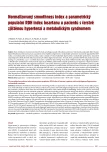The normalized smoothness index and parametric population RDH index of losartan in patients with newly diagnosed hypertension and metabolic syndrome
Authors:
I. Řiháček 1; P. Fráňa 1; D. Schwarz 2; M. Plachý 1; M. Souček 1
Authors‘ workplace:
II. interní klinika Lékařské fakulty MU a FN u sv. Anny Brno, přednosta prof. MU Dr. Miroslav Souček, CSc.
1; Institut biostatistiky a analýz Lékařské fakulty MU Brno, přednosta doc. RNDr. Ladislav Dušek, Ph. D.
2
Published in:
Vnitř Lék 2010; 56(9): 901-909
Category:
Original Contributions
Overview
Introduction:
Ambulatory blood pressure monitoring provides an opportunity to evaluate 24-hour efficacy of once daily preparations.
Aims of the study:
To evaluate 24-hour efficacy of losartan in patients with newly diagnosed hypertension and metabolic syndrome using the parametric population RDH index and normalized smoothness index.
Patient sample and methodology:
Twenty seven patients with newly diagnosed hypertension and with metabolic syndrome, sufficiently responding to blood pressure therapy with losartan, assessed using sphygmomanometer. 18 men, 9 women, mean age of 48 years, body mass index of 32.6 kg.m–2, before and after 1 year of therapy with losartan in the mean dose of 69 mg once a day. Blood pressure measured with sphygmomanometer and 24-hour ambulatory monitoring (SpaceLabs 90207) according to the European Society of Hypertension criteria. Hypertension was defined as sphygmomanometer-measured blood pressure values of more than or equal to 130 and/or 85 mm Hg. Fulfilment of at least 3 criteria of metabolic syndrome according to the definition by The Adult Treatment Panel III.
Results:
The population normalized smoothness index of losartan (± standard error of the mean) was 1.10 ± 0.13 for systolic pressure, 0.81 ± 0.11 for diastolic pressure and 1.00 ± 0.14 for mean arterial blood pressure. The parametric population RDH index of 24, 24, 0 for systolic pressure and 24, 24, 0 for diastolic pressure.
Conclusion:
Losartan at a mean dose of 69 mg once daily showed an adequate 24-hour efficacy in patients with newly diagnosed hypertension and metabolic syndrome responding to treatment when blood pressure was measured using sphygmomanometer and the effect expressed as the parametric population RDH index for systolic as well as diastolic pressure and when evaluating normalized smoothness index based on systolic blood pressure value and mean arterial pressure.
Key words:
hypertension – metabolic syndrome – normalized smoothness index – RDH index – losartan
Sources
1. Widimský J, Cífková R, Špinar J et al. Doporučení diagnostických a léčebných postupů u arteriální hypertenze – verze 2007. Doporučení České společnosti pro hypertenzi. Vnitř Lék 2008; 54 : 101 – 118.
2. Mancia G, De Backer G, Dominiczak A et la. 2007 Guidelines for the management of arterial hypertension: the task force for the management of arterial hypertension of the European Society of Hypertension (ESH) and of the European Society of Cardiology (ESC). J Hypertens 2007; 25 : 1105 – 1187.
3. Parati G, Omboni S, Rizzoni D et al. The smoothness index: a new, reproducible and clinically relevant measure of the homogeneity of the blood pressure reduction with treatment for hypertension. J Hypertens 1998; 16 : 1685 – 1691.
4. Aboy M, Fernández JR, Hermida RC. The population RDH index: a novel vector index and graphical method for statistical assessment of antihypertensive treatment reduction, duration and homogeneity. Blood Press Monit 2006; 11 : 143 – 155.
5. Homolka P et al. Monitorování krevního tlaku v klinické praxi a biologické rytmy. Praha: Grada Publishing 2010.
6. Detection, evaluation and treatment of high blood cholesterol in adults (Adult treatment panel III). National heart, lung and blood institute 2002. Available from: http:/ / www.nhlbi.nih.gov/ guidelines/ cholesterol/ atp3full.pdf.
7. Řiháček I, Souček M, Fráňa P et al. Stanovení hodnot 24 - hodinového ambulantního monitorování krevního tlaku odpovídajících kazuálnímu tlaku 130/ 80 mm Hg. Vnitř Lék 2008; 54 : 146 – 149.
8. 41st World Medical Assembly. Declaration of Helsinki: recommendations guiding physicians in biomedical research involving human subjects. Bull Pan Am Health Organ 1990; 24 : 606 – 609.
9. Sega R, Corrao G, Bombelli M et al. Blood pressure variability and organ damage in a general population: results from the PAMELA study. Hypertension 2002; 39 : 710 – 714.
10. Pickering TG, James GD. Ambulatory blood pressure and prognosis. J Hypertens 1994; 12 (Suppl 8): S29 – S33.
11. Mancia G, Frattola A, Groppeli A et al. Blood pressure reduction and end‑organ damage in hypertension. J Hypertens 1994; 12 (Suppl 8): S35 – S41.
12. Verdecchia P. Prognostic value of ambulatory blood pressure: current evidence and clinical implications. Hypertension 2000; 35 : 844 – 851.
13. Division of Cardio - Renal Drug Products. Clin 05/ 09/ 88 proposed guidelines for the clinical evaluation of antihypertensive drugs - draft. 1 – 9. 1988. Food and Drug Library. ISH Health Information.
14. Morgan T. 24hodinová kontrola krevního tlaku. Její význam, její hodnocení a používání poměru trough/ peak. Praha: Servier 1998.
15. Meredith PA. Trough/ peak ratios for antihypertensive agents. The issues in perspective. Drugs 1994; 48 : 662 – 666.
16. Levey AS, Bosch JP, Lewis JB et al. A more accurate method to estimate glomerular filtration rate from serum creatinine: a new prediction equation. Modification of Diet in Renal Disease Study Group. Ann Intern Med 1999; 130 : 461 – 470.
Labels
Diabetology Endocrinology Internal medicineArticle was published in
Internal Medicine

2010 Issue 9
Most read in this issue
- Heart and kidneys – a fatal relationship
- Our experience with endoscopic drainage of pancreatic pseudocysts
- Statin myopathy – rarity or reality?
- Adrenal incidentalomas – is the present management rational?
